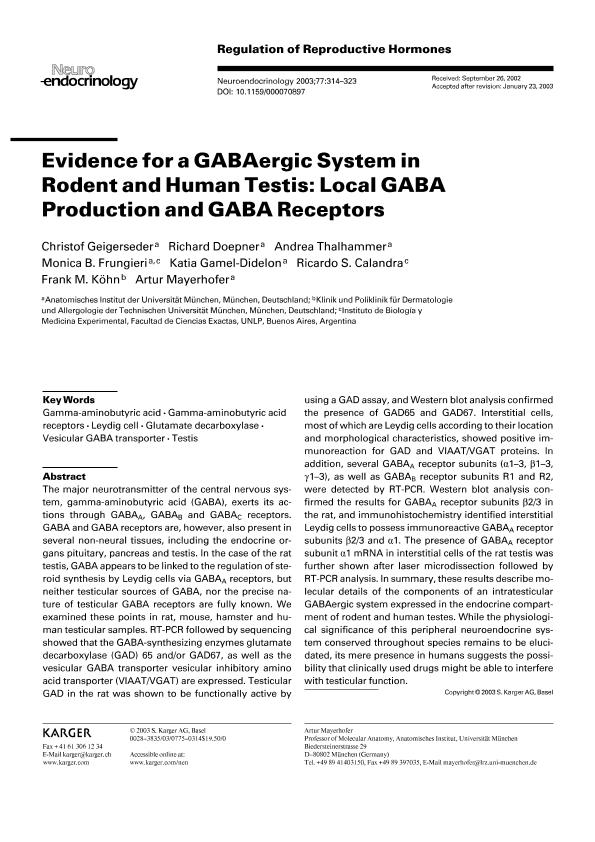Mostrar el registro sencillo del ítem
dc.contributor.author
Geigerseder, C.
dc.contributor.author
Doepner, R.
dc.contributor.author
Thalhammer, A,
dc.contributor.author
Frungieri, Monica Beatriz

dc.contributor.author
Gamel Didelon, K.
dc.contributor.author
Calandra, Ricardo Saul

dc.contributor.author
Köh, F. M.
dc.contributor.author
Mayerhofer, Artur

dc.date.available
2018-02-08T20:53:41Z
dc.date.issued
2003-05
dc.identifier.citation
Geigerseder, C.; Doepner, R.; Thalhammer, A,; Frungieri, Monica Beatriz; Gamel Didelon, K.; et al.; Evidence for a GABAergic system in rodent and human testis: local GABA production and GABA receptors; Karger; Neuroendocrinology; 77; 5; 5-2003; 314-323
dc.identifier.issn
0028-3835
dc.identifier.uri
http://hdl.handle.net/11336/36231
dc.description.abstract
The major neurotransmitter of the central nervous system, gamma-aminobutyric acid (GABA), exerts its actions through GABA(A), GABA(B) and GABA(C) receptors. GABA and GABA receptors are, however, also present in several non-neural tissues, including the endocrine organs pituitary, pancreas and testis. In the case of the rat testis, GABA appears to be linked to the regulation of steroid synthesis by Leydig cells via GABA(A) receptors, but neither testicular sources of GABA, nor the precise nature of testicular GABA receptors are fully known. We examined these points in rat, mouse, hamster and human testicular samples. RT-PCR followed by sequencing showed that the GABA-synthesizing enzymes glutamate decarboxylase (GAD) 65 and/or GAD67, as well as the vesicular GABA transporter vesicular inhibitory amino acid transporter (VIAAT/VGAT) are expressed. Testicular GAD in the rat was shown to be functionally active by using a GAD assay, and Western blot analysis confirmed the presence of GAD65 and GAD67. Interstitial cells, most of which are Leydig cells according to their location and morphological characteristics, showed positive immunoreaction for GAD and VIAAT/VGAT proteins. In addition, several GABA(A) receptor subunits (alpha1-3, beta1-3, gamma1-3), as well as GABA(B) receptor subunits R1 and R2, were detected by RT-PCR. Western blot analysis confirmed the results for GABA(A) receptor subunits beta2/3 in the rat, and immunohistochemistry identified interstitial Leydig cells to possess immunoreactive GABA(A) receptor subunits beta2/3 and alpha1. The presence of GABA(A) receptor subunit alpha1 mRNA in interstitial cells of the rat testis was further shown after laser microdissection followed by RT-PCR analysis. In summary, these results describe molecular details of the components of an intratesticular GABAergic system expressed in the endocrine compartment of rodent and human testes. While the physiological significance of this peripheral neuroendocrine system conserved throughout species remains to be elucidated, its mere presence in humans suggests the possibility that clinically used drugs might be able to interfere with testicular function.
dc.format
application/pdf
dc.language.iso
eng
dc.publisher
Karger

dc.rights
info:eu-repo/semantics/openAccess
dc.rights.uri
https://creativecommons.org/licenses/by-nc-sa/2.5/ar/
dc.subject
Gaba
dc.subject
Human
dc.subject
Testis
dc.subject
Rodent
dc.subject.classification
Bioquímica y Biología Molecular

dc.subject.classification
Medicina Básica

dc.subject.classification
CIENCIAS MÉDICAS Y DE LA SALUD

dc.subject.classification
Anatomía y Morfología

dc.subject.classification
Medicina Básica

dc.subject.classification
CIENCIAS MÉDICAS Y DE LA SALUD

dc.title
Evidence for a GABAergic system in rodent and human testis: local GABA production and GABA receptors
dc.type
info:eu-repo/semantics/article
dc.type
info:ar-repo/semantics/artículo
dc.type
info:eu-repo/semantics/publishedVersion
dc.date.updated
2017-12-28T13:40:44Z
dc.identifier.eissn
1423-0194
dc.journal.volume
77
dc.journal.number
5
dc.journal.pagination
314-323
dc.journal.pais
Suiza

dc.journal.ciudad
Basel
dc.description.fil
Fil: Geigerseder, C.. Universität München; Alemania
dc.description.fil
Fil: Doepner, R.. Universität München; Alemania
dc.description.fil
Fil: Thalhammer, A,. Universität München; Alemania
dc.description.fil
Fil: Frungieri, Monica Beatriz. Consejo Nacional de Investigaciones Científicas y Técnicas. Instituto de Biología y Medicina Experimental. Fundación de Instituto de Biología y Medicina Experimental. Instituto de Biología y Medicina Experimental; Argentina. Universidad de Buenos Aires. Facultad de Medicina; Argentina. Universität München; Alemania
dc.description.fil
Fil: Gamel Didelon, K.. Universität München; Alemania
dc.description.fil
Fil: Calandra, Ricardo Saul. Consejo Nacional de Investigaciones Científicas y Técnicas. Instituto de Biología y Medicina Experimental. Fundación de Instituto de Biología y Medicina Experimental. Instituto de Biología y Medicina Experimental; Argentina
dc.description.fil
Fil: Köh, F. M.. Technischen Universität München; Alemania
dc.description.fil
Fil: Mayerhofer, Artur. Universität München; Alemania
dc.journal.title
Neuroendocrinology

dc.relation.alternativeid
info:eu-repo/semantics/altIdentifier/url/https://www.karger.com/Article/Abstract/70897
dc.relation.alternativeid
info:eu-repo/semantics/altIdentifier/doi/http://dx.doi.org/10.1159/000070897
dc.relation.alternativeid
info:eu-repo/semantics/altIdentifier/pmid/12806177
Archivos asociados
